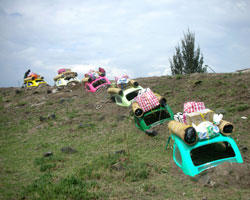Chew on this

Is there any person in the New York metropolitan region who at one time or another has not recoiled from stepping on a used piece of chewing gum? Or worse, found a piece stuck on the bottom of a desk or table? Ugh. Though slightly gross, very annoying and morally disrespectful, it’s a part of what we euphemistically call the “urban experience.” Now, Mexican-born artist Betsabee Romero has taken gum to a new level using it as a material in her artwork.
Romero loves chewing gum. It represents the detritus of a globalized society. Reportedly, Americans spend $2.5 billion annually on chewing gum. And as Patrice Giasson, the exhibition curator points out, “it’s frankly one of those commodities which is hard to get rid of. We chew gum, but don’t consume it,” which appears to be precisely what fascinates Romero. She transforms it, refashions it as she does with other decaying symbols of an industrialized society, such as old cars and used tires. As with the gum, tires were once made from trees native to Mexico so their meaning transcends the material and becomes a monumental symbol of waste and wastefulness. There is still time to see Romero’s work, which will be on view as Lagrimas Negras/Black Tears at the Neuberger Museum (www.neuberger.org) until August 14. You can also see a short video of this exhibition at http://www.youtube.com/watch?v=8Ink6DJkXD8.
But don’t expect to see a group of still lifes. “Romero’s palette is the car and its components,” says the curator. It may be that Romero’s interest in cars stems in part from the five million cars that roam the streets of Mexico City. “In her work, the cars express excesses of a global society,” says Giasson, “but they are also a symbol of the migrant journey.” Through the car, we can go with Romero to that border crossing in Mexico and feel both the danger and promise of the American dream.
Prepare yourself. You will be greeted at the campus entrance with a battered and decorated 1975 El Dorado Cadillac, now transformed into a work of art called “Fukushima,” which refers to the media frenzy surrounding the recent tsunami in Japan and the fear that radioactive particles could find their way here: http://www.youtube.com/watch?v=G39UTqwAWJw. Romero spent a month in residence at Purchase working with a crew of art students to create that piece, as well as another one called “All Paths Lead To The Supermarket,” in which six supermarket carts are reincarnated as a monumental sculpture, with energy akin to a Ferris wheel. http://www.youtube.com/watch?v=qeELzFmey4Y&feature=related
“When you think about it,” says Giasson, “it represents an empire of consumption in which everything is for sale.” And that is what this artist asks us to do…think…think about the world as a huge marketplace and the vast emptiness of an era of globalization. Kind of makes you think, doesn’t it?


Connect with Janet